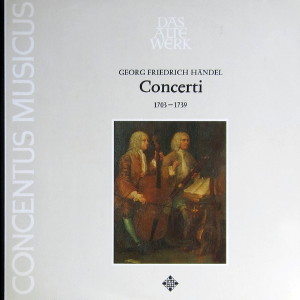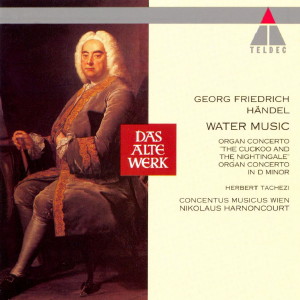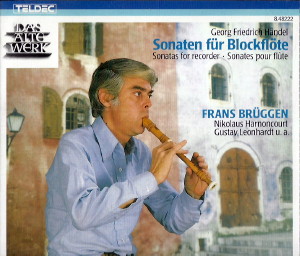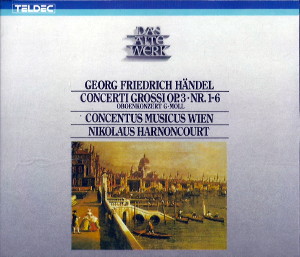 |
1 LP -
SAWT 9618-A - (p) 1974
|
 |
| 1 CD -
4509 93668-2 - (c) 1994 |
 |
| 2 CD -
8.48222 ZA - (c) 1986 |
 |
| 2 CD -
8.35545 ZA - (c) 1985 |
|
| Georg Friedrich
Händel (1685-1759) |
|
|
|
|
|
|
|
| Concerti
- 1703-1739 |
|
|
|
|
|
|
|
Concerto F-dur für Orgel, 2
Oboen, Streicher und B.c. "The Cuckoo
and the Nightingale", Hwv 295
|
|
13' 01" |
A1 |
| (2. april 1739 nach der
Triosonate op. 5/6, die noch aus seiner
Frühzeit stammt) |
|
|
|
- Larghetto
|
2' 09" |
|
|
- Allegro
|
3' 25" |
|
|
| - Organo ad libitum ex A |
1' 06" |
|
|
| - Larghetto |
3' 13" |
|
|
| - Allegro |
3' 08" |
|
|
Concerto d-moll für Flöte,
Violine, Violoncello und B.c.
|
|
7' 57" |
A2 |
(zwischen 1706-1716)
|
|
|
|
| - Adagio |
2' 10" |
|
|
- Allegro
|
1' 33" |
|
|
| - Largo |
1' 10" |
|
|
| - Allegro |
3' 04" |
|
|
| Concerto g-moll für Oboe,
Streiocher und B.c., Hwv 287 |
|
8' 37" |
B1 |
| (1703) |
|
|
|
| - Grave |
2' 32"
|
|
|
| - Allegro |
1' 52" |
|
|
- Sarabande, Largo
|
2' 15" |
|
|
| - Allegro |
1' 58" |
|
|
Sonate à 3 F-dur "1. Hautbois
1 Basson et Basso continuo de Mister
Handel", Hwv 383
|
|
7' 15" |
B2 |
(Ca. 1710)
|
|
|
|
| - Adagio |
1' 54"
|
|
|
| - Allegro |
1' 56" |
|
|
| - Largo |
1' 40" |
|
|
| - Allegro |
1' 45" |
|
|
Concerto D-dur für 2
Violinen, Violoncello und B.c.
|
|
5' 44" |
B3 |
| (zwischen 1706-1716) |
|
|
|
- Con Contento
|
1' 39" |
|
|
| - Allegro |
1' 35" |
|
|
| - Largo |
1' 30" |
|
|
| - Presto |
1' 00" |
|
|
|
|
|
|
CONCENTUS MUSICUS
WIEN (mit
Originalinstrumenten)
|
|
| -
Leopold Stastny, Traverflöte |
-
Josef de Sordi, Violine |
|
| -
Jürg Schaeftlein, Oboe |
-
Kurt Theiner, Viola, Violetta |
|
| -
Paul Hailperin, Oboe |
-
Milan Turkovic, Fagott |
|
| -
Alice Harnoncourt, Violine |
-
Nikolaus Harnoncourt, Violoncello |
|
| -
Walter Pfeiffer, Violine |
-
Eduard Hruza, Violone |
|
| -
Peter Schoberwalter, Violine |
-
Herbert Tachezi, Cembalo, Orgel |
|
| -
Wilhelm Mergl, Violine |
-
Johann Sonnleitner, Cembalo |
|
|
|
| Nikolaus Harnoncourt, Dirigent |
|
|
Luogo
e data di registrazione
|
| Palais
Rasumowsky, Vienna (Austria) - marzo e
aprile 1973 |
|
Registrazione
live / studio
|
| studio |
Producer
/ Engineer
|
-
|
Prima Edizione CD
|
Teldec
"Das Alte Werk" - 4509 93668-2 - (1 cd)
- 71' 46" - (c) 1994 - ADD/DDD -
(Concerto F-dur, Hwv 295)
Teldec "Das Alte Werk" - 8.48222 ZA - (2
cd) - 51' 21" + 53' 14" - (c) 1986 - AAD
- (Sonata à 3 F-dur, Hwv 383)
Teldec "Das Alte Werk" - 8.35545 ZA - (2
cd) - 42' 47" + 37' 14" - (c) 1985 - AAD
- (Concerto g-moll, Hwv 287)
|
Prima
Edizione LP
|
Telefunken "Das
Alte Werk" - SAWT 9618-A
- (1 lp) - 43'
03"
- (p) 1974
|
|
|
Notes
|
George
Frideric Handel
was the first great man of
the world among the
composers of his epoch. From
the very
beginnings of his music
career he was always
successful, both as
composer and as a
fascinating organ virtuoso
and improvisor. He
always composed his
works for a certain
occasion, for a certain
region and for an
audience with which he
was well acquainted. His
enormous
success, therefore, is
largely based on the
fact that he couched
his musical statements
in a "language" which
the particular
audience understood,
that therefore, like a
good orator, he
formulated his
thoughts according to
the background of the
listener. In this
respect his works are
reflections of the
rapport between
composer and listener,
although he was fully
conscious of the moral
duty of the artist to
hold the listener in
such a way that, on
hearing the music, he
might become a
different, a better
human being.
Händel
had studied all the
music styles of his
period from the very
foundations. At the
age of 18 he was
working at the
Hamburg opera as
violinist,
harpsichordist and
composer. Five years
later he travelled
to Italy, the
undisputed centre of
Baroque musical
life, where he
entered the circle
close to cardinal
Ottoboni, the great
patron of the arts.
He worked together
with the most
important Italian
composers (Corelli,
Scarlatti) and
studied their manner
of writing. Thus he
established himself
in every sector,
becoming a genuine
expert, able to play
himself what he
composed. His
education and
proficiency in
languages, his taste
in every field of
art (later in
England hea acquired
an important
collection of
paintings) sharpened
his innate skill at
accurately touching
the nerve of the
public. Already from
his period in
Hamburg Händel
was counted as one
of the famous
personalities in
international music.
Following his stay
in Italy (1706-1710)
and his success
there, the German
princely courts
almost fought with
each other to get
this new star under
firm contract, while
Händel
himself recognized
and made the most of
his market value. He
was one of the few
pre-classical
composers who also
made their way in
social and economic
life. His
collaboration with
publishers ensured
his works widespread
distribution and
provided him with
safe revenues. It is
therefore not
surprising that
large sections of Händel's
compositions are
available in various
contemporary
editions, many of
them in differing
versions and
instrumentations.
Nikolaus
Harnoncourt
|
|
Nikolaus
Harnoncourt (1929-2016)
|

|

|
|